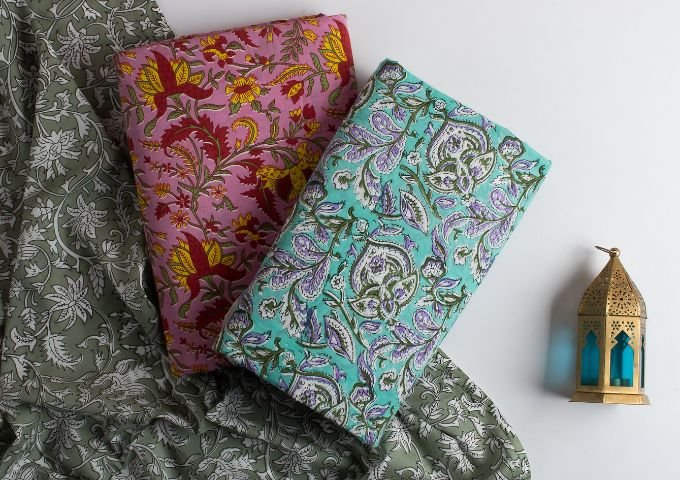Block printing is an ancient technique practised for centuries, showcasing the beauty of handcrafted textiles. This time-honoured art form involves stamping intricate patterns onto fabric using hand-carved wooden blocks, resulting in unique and stunning designs. Block print fabric is celebrated for its rich history, sustainable production methods, and timeless aesthetic appeal.
The Origins and History of Block Printing
The roots of block printing trace back to ancient China over 4,000 years ago, before spreading to India, Persia, and Egypt. India, in particular, became a global hub for block printing, with regions like Rajasthan and Gujarat emerging as centres of excellence. The Mughals played a significant role in advancing this craft, introducing elaborate floral and geometric motifs that remain popular today.
Indian block printing has since gained international recognition, with cities such as Jaipur, Bagru, and Sanganer producing some of the finest examples of this art. The vibrant colours, natural dyes, and intricate detailing make Indian block print fabric highly desirable for both fashion and home décor.
The Block Printing Process
1. Designing the Wooden Blocks
The first step in block printing is carving intricate designs onto wooden blocks. Skilled artisans use chisels and hammers to etch patterns into hardwood, creating detailed motifs that will be transferred onto fabric. Each block represents a specific part of the design, and multiple blocks may be used to create multi-coloured prints.
2. Preparing the Fabric
The chosen fabric, often cotton, silk, or linen, is pre-washed to remove impurities and improve dye absorption. It is then stretched and pinned to a flat surface to ensure a smooth application of prints.
3. Mixing the Natural Dyes
Traditional block printing uses natural dyes derived from plants, minerals, and even insects. Popular colours include indigo, madder red, and turmeric yellow, which are eco-friendly and non-toxic.
4. Hand-Stamping the Fabric
The carved wooden block is dipped into the dye and firmly pressed onto the fabric in a precise, repetitive motion. This step requires a steady hand and keen attention to detail, as artisans must align the blocks to create a seamless pattern. The process is repeated with different blocks if multiple colours are used.
5. Drying and Finishing
After printing, the fabric is left to dry naturally. Some prints undergo additional treatments such as steaming or washing to fix the colours, ensuring long-lasting vibrancy. The finished fabric is then ready to be tailored into garments, upholstery, or home décor items.
Types of Block Print Designs
Block printing exhibits a wide range of styles and patterns, each reflecting the cultural influences of its region. Some notable styles include:
Bagru Prints: Characterized by earthy tones and floral motifs, Bagru prints originate from Rajasthan and use a resist-dyeing technique.
Sanganeri Prints: Delicate floral patterns set against a white background, often used in sarees and bed linens.
Ajrakh Prints: Featuring intricate geometric designs, Ajrakh prints are created using natural dyes and are prominent in Sindh and Kutch.
Dabu Prints: A mud-resist technique where designs are hand-painted before dyeing, resulting in unique patterns with a rustic appeal.
The Sustainability of Block Printing
One of the key advantages of block printing is its eco-friendliness. Unlike mass-produced textiles, block-printed fabrics are handcrafted with minimal environmental impact. Many artisans use organic cotton and natural dyes, eliminating the harmful chemicals associated with synthetic textiles. Additionally, block printing supports rural artisans and preserves traditional craftsmanship, making it a sustainable and ethical choice for conscious consumers.
Applications of Block Print Fabric
Block print fabrics are incredibly versatile and can be used in various ways:
1. Fashion Industry
Block-printed fabrics are widely used to create stunning ethnic wear such as sarees, kurtas, and dupattas. Many contemporary designers incorporate block prints into Western silhouettes, producing dresses, tunics, and scarves that blend tradition with modernity.
2. Home Décor
Block prints bring a touch of artistry to home interiors. They are commonly used in bedspreads, curtains, cushion covers, and table linens, adding warmth and character to any space.
3. Accessories
From tote bags to scarves and wallets, block print fabrics are used to craft stylish accessories that are both functional and aesthetically pleasing.
How to Care for Block Print Fabrics
To maintain the beauty and longevity of block-printed textiles, proper care is essential:
Hand wash with cold water to prevent colour bleeding.
Use mild detergents to preserve fabric integrity.
Dry in the shade to avoid fading from direct sunlight.
Iron on low heat to keep the prints intact and crisp.
Also, read more about Icespiceleaks.
Why Choose Block Print Fabric?
1. Handcrafted Beauty
Each block-printed fabric carries the unique touch of the artisan who created it, making every piece a work of art.
2. Ethical and Sustainable
By choosing block-printed textiles, consumers support traditional craftsmanship and contribute to a more sustainable fashion industry.
3. Timeless Appeal
Block prints have endured for centuries and remain as fashionable today as they were in ancient times. Their versatility ensures they never go out of style.
Conclusion
Block print fabric is more than just a textile; it represents a legacy of artistry, tradition, and sustainable craftsmanship. Whether used for fashion, home décor, or accessories, these handcrafted textiles add a touch of elegance and history to any setting.



